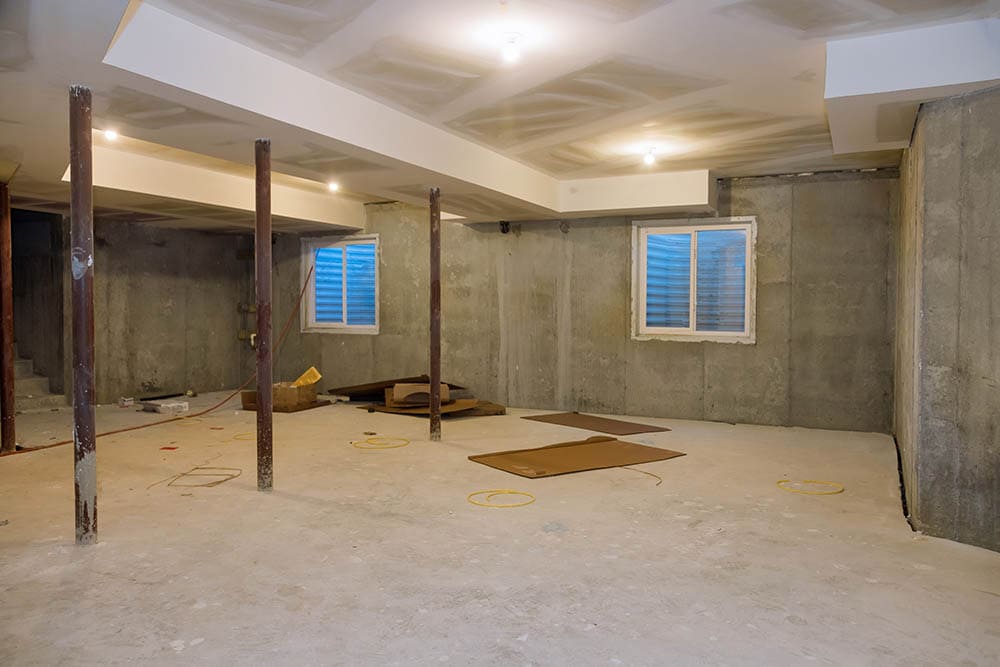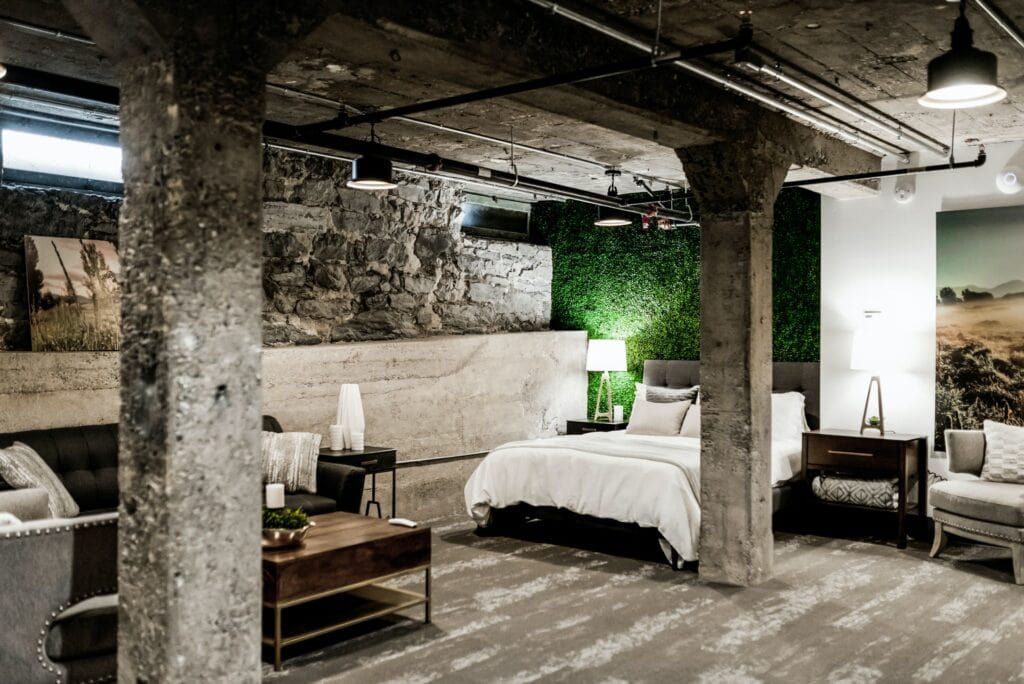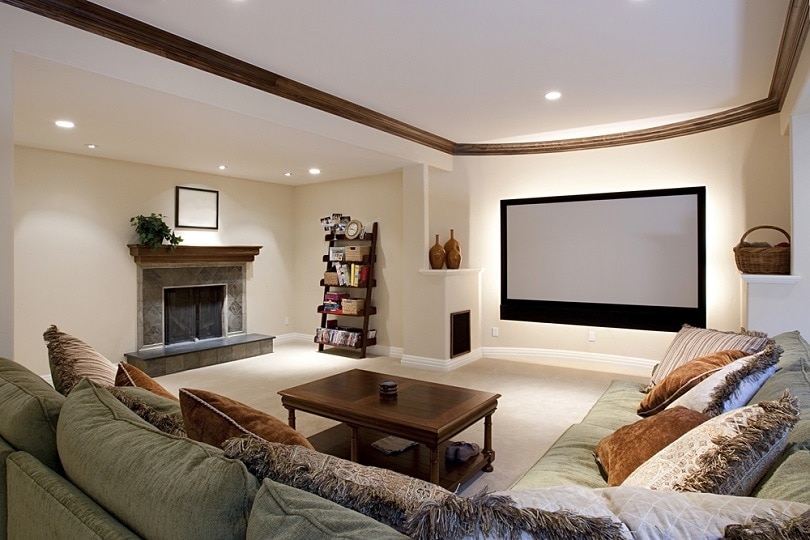Why Do Houses Have Basements? Uses, Alternatives, & FAQ
-
Pete Ortiz
- Last updated:

Although concrete slabs are slowly but steadily turning into the prime foundation choice for newly-built American houses, basements are still very popular. This is especially true for the western and northern states. So, why do houses have them in the first place? Basements serve three purposes: they can be used for storage, running pipes and cables, and as full-fledged, standalone rooms for work and leisure.
But is a basement necessary, though? Are there any other uses for it, or not? Should you maybe go with a crawl space or a slab instead? How much will it cost to build a basement in the US? In this guide, we’ll go over every single one of these questions and figure out why houses in the States have basements.
 What Is a Basement? Can You Build It Anywhere?
What Is a Basement? Can You Build It Anywhere?
Known as a cellar in the past, a basement is the foundation of a house, and it can be either fully or partially underground. Essentially, it’s an extra room right below the first floor. Built from block walls or poured concrete, basements are quite sturdy and can withstand natural hazards, including hurricanes, storms, and fires. And what about flooding—can a basement protect against that?
Yes, it can, but only to a certain extent. If you live somewhere in the South (Louisiana, for example), or you’re planning on building a house near bodies of water, a basement might not be the best idea. In other areas, where the soil is too weak to support such a structure, basements are very rare. In contrast, they are very common in the West and in the North where the frost line is several feet below ground.

The Best Uses for a Basement
A finished, heated, and sealed basement is quite flexible and can be multiple things at once.
- A place where you can rest/work. A playroom, home theater, office, and even a photo/video studio—you do the picking! Often, basements are used as a guest suite or a room for teenagers. You will have to build a bathroom to call it a full-fledged room, though, and that won’t be at all cheap: $3,000–25,000. If the plumbing and fixtures are already there, you’ll be able to save 20–30% and more if you handle the installation.
- Extra room for storage. You can put all your old equipment, tools, clothes, toys, and everything else in between in the basement. If you’re good at organizing, a lot can be stored there. Some people also keep food in the cellar (mostly canned). In a well-ventilated and waterproofed basement, you won’t have to worry about the food going bad.
- Pipes and wires. Have you ever wondered where all the pipes, supply lines, tanks, fuse boxes, and HVAC systems are in your house? Well, you’re likely to find them in the basement! The wires, plumbing, and ductwork are usually running behind the walls or below the floor. As for the tank and the furnace, you can use curtains, a room divider, or cabinets to hide them from the naked eye.
So, Is a Basement Necessary?
No state, county, or city requires a homeowner to have a basement. So, no, it’s not mandatory. With that said, if you want to protect your house from shifting during the winter days (when the so-called “freeze-thaw cycle” starts), a basement will help with that. It will also help reduce the cooling and heating bills by keeping the temperature in the entire house balanced.
And, if you live in an area that’s prone to storms and tornadoes, a slab or crawl space won’t be able to protect you; a basement will. The same can’t be said about earthquakes, though, because they are known to make upper stories collapse right into the basement. Still, as a long-term investment, it will be worth it. Ultimately, it’s up to you to decide whether you want to build it or not.

What Are the Alternatives?
If you’re on a tight budget, you can go with a crawl space instead. It won’t be nearly as large, comfortable, or warm as a basement, though. The term “crawl space” is used to describe the area (usually 3–4 feet in height) between the soil/ground and the main floor of the house. Sometimes, it’s sealed/heated or it can be ventilated. In any case, you can run pipes and wires down there and maybe store some canned food.
Not a big fan of tight spaces? Then how about building a concrete slab: a thick layer of concrete that serves as the foundation for the house? All the plumbing, cables, and whatnot will be buried underneath it, and there won’t be any storage or living space. On the bright side, slabs are practically immune to flooding, take little time to build, and keep insects and critters at bay.
How Many Houses in the US Have Basements?
The short answer is—not many. First, only three regions in America are big on basements. The rest prefer slabs and crawl spaces. That’s because they’re significantly cheaper and take less time to build. Second, as we learned earlier, it’s not recommended to build a basement near wetlands or on soil with high water content. In West North Central, about 80% of newly-built single-family homes have basements.
In New England, 70% of residents choose to go with basements instead of the other two options. In the Mid Atlantic, the percentage is lower but still decent: 57.3%. And what about the South? Well, you’ll have a hard time finding anything else than a concrete slab there. Basements represent less than 1% of foundations in the Southern states!
Are Basements Expensive to Build?
This greatly depends on the size of the basement, grading, materials used, the quality of the finish, and the area that you live in. Generally, they do, indeed, cost a lot to build—$25,000–80,000 for the average-sized house in the US ($10–40 per square foot). It’s still going to be significantly cheaper compared to building a separate room. Besides, an unfinished basement will cost 30–50% less, coming in at $35,000–40,000.
As always, before hiring a contractor to construct a basement for you, make sure to get quotes and estimates from 3–4 companies. Also, don’t forget to talk about deadlines and discounts. If you’re open to suggestions, you might change your mind and opt for a slab or a crawl space instead to lower the budget.
Adding the Basement at a Later Stage
Lastly, there’s the option of building a basement under an existing house. But that will cost you twice as much as building it from the get-go, during planning and excavation. For most homeowners, adding an extra room off to the side or even onto the top of their homes will be a better choice, however.

How Big Should the Basement Be?
Back in the day, there were all kinds of shapes and sizes for underground floors and foundations. These days, contractors follow one simple, yet golden rule: the basement should be the same size as the rest of the house. For example, if you’re the proud owner of a 2,500-square feet house, the basement needs to be just as big. As for the average size, most basements are usually in the 500–1,500 square feet range.
And what about the height, you might ask? Well, 8–10 feet have proven to be just right for heating, ventilation, impact resistance, and comfort. You can go higher, of course, but do talk this over with the contractor to make sure that won’t jeopardize structural integrity. Going lower than that might be a violation of the law. You’ll have to check with local build codes on that one. In most US states, the basement can’t be lower than 7 feet.
How Do You Protect It Against Floods?
Weatherproofing is the most effective solution against floods. There are lots of decent sealant products out there that prevent water from seeping through the cracks. Window well covers, grading, and a reliable drainage system will also come in handy. Oh, and make sure that the gutters, downspouts, sump pump, and French drains are not damaged or compromised in any way.
Conclusion
Can you do without a basement? Absolutely! However, if you have the time, money, and desire to add an underground room as the foundation of the house, a basement will be an excellent long-term investment. It will last for many decades and significantly boost the resale value of your home. But, it won’t be cheap, especially if you weatherproof it to fight cold, storms, and floods.
Basements are usually where we put our laundry mats, HVAC systems, and water tanks. Or, they can be a living space where we relax, have a great time, and get some work done. Yes, there’s a lot to love about basements, which is exactly why tens of millions of houses in the US have them.
- What is the Average Finished Basement Size in the USA?
- How Much Does It Cost To Add A Bathroom?
- COST TO ADD A BATHROOM IN THE BASEMENT
- How Much Does It Cost To Build A Basement Or Foundation?
- Is It Possible to Build a Basement Under an Existing House?
- The Purpose Of A Basement (And Why Some States Don’t Have Them)
- WorldPopulation – Frost Lines by State 2022
- Evaluate Your House for Basement Finishing
- NAHB – Basements Continue to Fall Out of Favor
- WHY ARE THERE NO BASEMENTS IN SOME STATES?
- Wikipedia – Basement
- Wikipedia – Weathering
Featured Image Credit: ungvar, Shutterstock
Contents

 What Is a Basement? Can You Build It Anywhere?
What Is a Basement? Can You Build It Anywhere?